& Construction

Integrated BIM tools, including Revit, AutoCAD, and Civil 3D
& Manufacturing

Professional CAD/CAM tools built on Inventor and AutoCAD
Any referenced datasets can be downloaded from "Module downloads" in the module overview.
Transcript
00:03
InfoWorks WS Pro’s critical link analysis, or CLA, run type
00:08
allows automated testing and reporting of the effects of failure of a selection of links.
00:13
First, you define the time of outage and method of failure for the selected links.
00:18
Then, a simulation is run either for each selected link, or for each isolation area in the selection, in turn.
00:25
It is best practice to start with a base run.
00:28
This is optional, but recommended so that you can familiarize yourself with the model,
00:33
ensure the model does not have any validation errors before you begin the CLA,
00:37
and, if it is a new model, be able to make comparisons with the CLA run.
00:42
In the Model Group window, right-click Run Group and select New > Run.
00:48
In the Schedule Hydraulic Run dialog, type “Base run” into the Title field, and then enable Experimental.
00:55
You can check the validity of the baseline by right-clicking on Control simulation, clicking Open As… and selecting Validation Results.
01:05
No errors or warnings in the Output window means your model is suitable to perform a CLA.
01:12
Next, from the Model Group, drag and drop the Network, Control, and Demand diagram into their respective panes in the dialog.
01:23
Then, in the Run Parameters group box, adjust the Start date and time to May 2nd, 2022 at midnight.
01:31
Change the End date and time to May 3rd, 2022 at midnight.
01:36
Leave all other values in the Run Parameters group box unchanged.
01:41
Click Save, and then Run.
01:44
Be aware that the more links you include in a CLA run, the longer the simulation will take.
01:50
You can find the exact number of pipes in the entire network by clicking the Network menu and picking Network overview,
01:57
which lists the total number of objects by type in the network.
02:01
To create the CLA run, right-click Run Group and select New > Run.
02:07
In the Schedule Hydraulic Run dialog, enter “CLA” in the Title field, and then enable Experimental.
02:14
Then, drag and drop the same network, control, and demand diagram as were used for the base run.
02:20
In the Run Parameters group box, adjust the Start time to May 2nd, 2022 and the End time to May 3rd, 2022.
02:30
In the Run Type group box, expand the drop-down menu and select Critical Link Analysis.
02:36
This opens the Critical Link Analysis Options dialog.
02:40
From the Model Group, drag the Pipes selection list and drop it into the Selection List pane.
02:46
Note the values in the Minimum Pressure group box.
02:49
In this example, the minimum pressure is set to 10, and the duration is set to 30 minutes.
02:55
This means that, in the event of a service interruption such as a pipe break or closure,
02:60
a pressure drop below 10 meters for longer than 30 minutes is considered a failure.
03:05
In the Failure count type: group box, enable Customer Points.
03:11
In the Single Pipe or Isolation Area group box,
03:14
you select whether a single link or a group of links in an isolation area is to be closed for analysis.
03:20
Enabling Close single link for each test means that each link included in the selection list is closed and simulated one at a time.
03:29
Enabling Close isolation area for each test means that for each isolation Area Code found in the selection list,
03:36
all links in the isolation area will be closed and simulated at once.
03:41
There will be one simulation run per isolation area.
03:45
Note that you can check the box next to Discard time varying results, which can be beneficial when working on larger models.
03:52
Check this box so that the CLA will only generate a summary report and criticality values.
03:59
Next, click Criticality criteria options… to open the Criticality Criteria grid.
04:04
You can edit this grid to adjust the criticality criteria.
04:08
In this example, because you are working on only a small part of a network with roughly 3,500 customer points,
04:15
some of the default values can be lowered to reflect a smaller number of customers.
04:20
Adjust the values in the Below Minimum Pressure column to the following, starting in the first row:
04:32
In the Isolated (Count) column, change the values to 0, 10, 20, 30, and 40.
04:40
Note the Isolated Key Customers column.
04:43
You can specify key customers, such as hospitals or emergency services,
04:47
so that if a service interruption impacts them, it will automatically receive a high criticality value.
04:54
Leave the default values in this column, then click OK.
04:58
Click OK again in the Critical Link Analysis Options dialog to close it.
05:03
Back in the Schedule Hydraulic Run dialog, click Save and then Run.
05:08
A notification will appear, informing you of how many simulations the CLA will run, and that it may take a long time.
05:16
Click Yes to continue.
00:03
InfoWorks WS Pro’s critical link analysis, or CLA, run type
00:08
allows automated testing and reporting of the effects of failure of a selection of links.
00:13
First, you define the time of outage and method of failure for the selected links.
00:18
Then, a simulation is run either for each selected link, or for each isolation area in the selection, in turn.
00:25
It is best practice to start with a base run.
00:28
This is optional, but recommended so that you can familiarize yourself with the model,
00:33
ensure the model does not have any validation errors before you begin the CLA,
00:37
and, if it is a new model, be able to make comparisons with the CLA run.
00:42
In the Model Group window, right-click Run Group and select New > Run.
00:48
In the Schedule Hydraulic Run dialog, type “Base run” into the Title field, and then enable Experimental.
00:55
You can check the validity of the baseline by right-clicking on Control simulation, clicking Open As… and selecting Validation Results.
01:05
No errors or warnings in the Output window means your model is suitable to perform a CLA.
01:12
Next, from the Model Group, drag and drop the Network, Control, and Demand diagram into their respective panes in the dialog.
01:23
Then, in the Run Parameters group box, adjust the Start date and time to May 2nd, 2022 at midnight.
01:31
Change the End date and time to May 3rd, 2022 at midnight.
01:36
Leave all other values in the Run Parameters group box unchanged.
01:41
Click Save, and then Run.
01:44
Be aware that the more links you include in a CLA run, the longer the simulation will take.
01:50
You can find the exact number of pipes in the entire network by clicking the Network menu and picking Network overview,
01:57
which lists the total number of objects by type in the network.
02:01
To create the CLA run, right-click Run Group and select New > Run.
02:07
In the Schedule Hydraulic Run dialog, enter “CLA” in the Title field, and then enable Experimental.
02:14
Then, drag and drop the same network, control, and demand diagram as were used for the base run.
02:20
In the Run Parameters group box, adjust the Start time to May 2nd, 2022 and the End time to May 3rd, 2022.
02:30
In the Run Type group box, expand the drop-down menu and select Critical Link Analysis.
02:36
This opens the Critical Link Analysis Options dialog.
02:40
From the Model Group, drag the Pipes selection list and drop it into the Selection List pane.
02:46
Note the values in the Minimum Pressure group box.
02:49
In this example, the minimum pressure is set to 10, and the duration is set to 30 minutes.
02:55
This means that, in the event of a service interruption such as a pipe break or closure,
02:60
a pressure drop below 10 meters for longer than 30 minutes is considered a failure.
03:05
In the Failure count type: group box, enable Customer Points.
03:11
In the Single Pipe or Isolation Area group box,
03:14
you select whether a single link or a group of links in an isolation area is to be closed for analysis.
03:20
Enabling Close single link for each test means that each link included in the selection list is closed and simulated one at a time.
03:29
Enabling Close isolation area for each test means that for each isolation Area Code found in the selection list,
03:36
all links in the isolation area will be closed and simulated at once.
03:41
There will be one simulation run per isolation area.
03:45
Note that you can check the box next to Discard time varying results, which can be beneficial when working on larger models.
03:52
Check this box so that the CLA will only generate a summary report and criticality values.
03:59
Next, click Criticality criteria options… to open the Criticality Criteria grid.
04:04
You can edit this grid to adjust the criticality criteria.
04:08
In this example, because you are working on only a small part of a network with roughly 3,500 customer points,
04:15
some of the default values can be lowered to reflect a smaller number of customers.
04:20
Adjust the values in the Below Minimum Pressure column to the following, starting in the first row:
04:32
In the Isolated (Count) column, change the values to 0, 10, 20, 30, and 40.
04:40
Note the Isolated Key Customers column.
04:43
You can specify key customers, such as hospitals or emergency services,
04:47
so that if a service interruption impacts them, it will automatically receive a high criticality value.
04:54
Leave the default values in this column, then click OK.
04:58
Click OK again in the Critical Link Analysis Options dialog to close it.
05:03
Back in the Schedule Hydraulic Run dialog, click Save and then Run.
05:08
A notification will appear, informing you of how many simulations the CLA will run, and that it may take a long time.
05:16
Click Yes to continue.
InfoWorks WS Pro’s critical link analysis, or CLA, run type allows automated testing and reporting of the effects of failure of a selection of links. First, define the time of outage and method of failure for the selected links. Then, a simulation is run either for each selected link, or for each isolation area in the selection, in turn.
IMPORTANT: Check the validity of the baseline by right-clicking Control simulation > Open As… and selecting Validation Results. No errors or warnings in the Output window means that the model is suitable to perform a CLA.
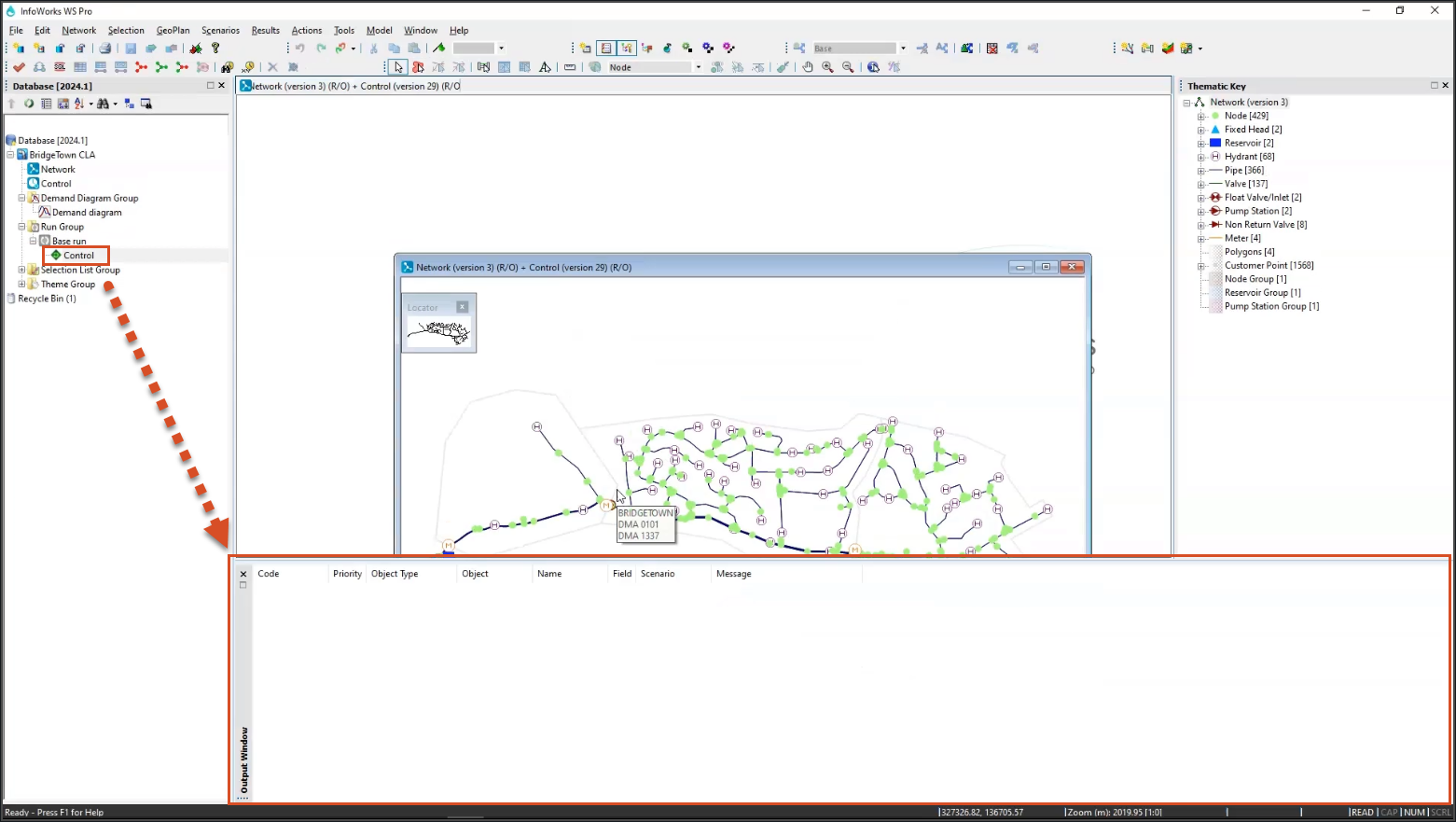
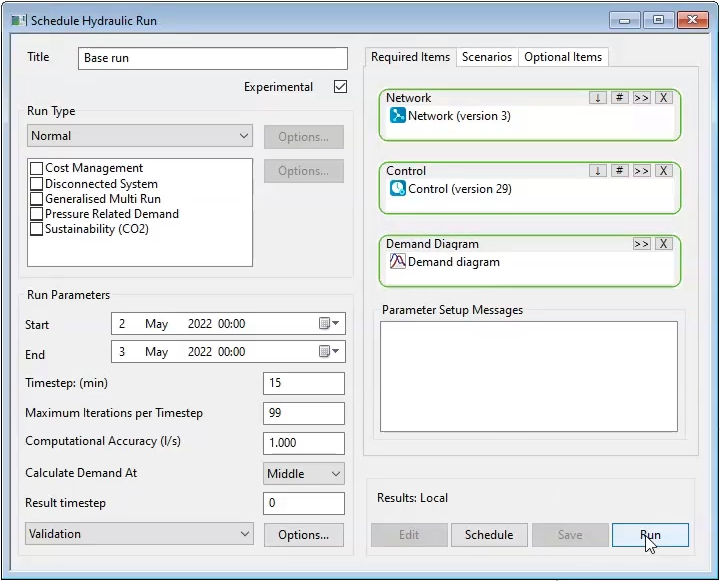
Note: To find the exact number of pipes in the entire network, click the Network menu and select Network overview.
To create the CLA run:
Note: The values in the Minimum Pressure group box. In this example, the minimum pressure is set to 10, and the duration is set to 30 minutes.
In the Single Pipe or Isolation Area group box, select whether a single link or a group of links in an isolation area is to be closed for analysis:
Note: When working on large models, enable Discard time varying results so that the CLA will only generate a summary report and criticality values.
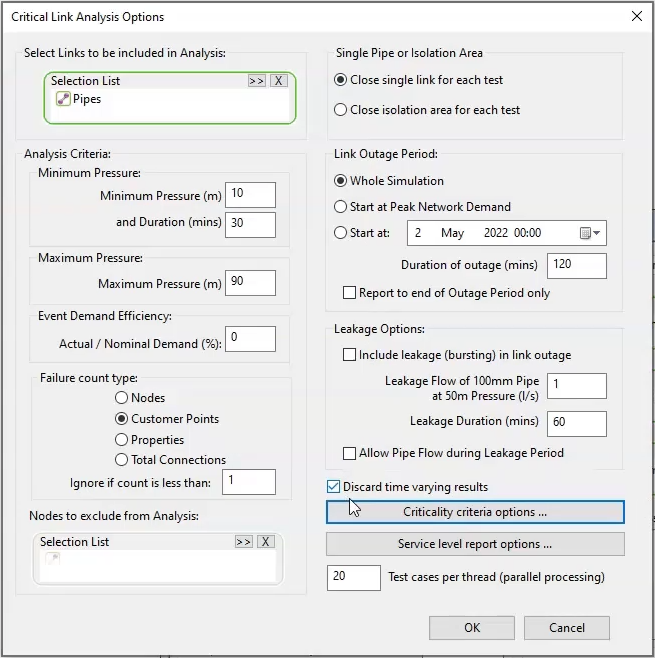
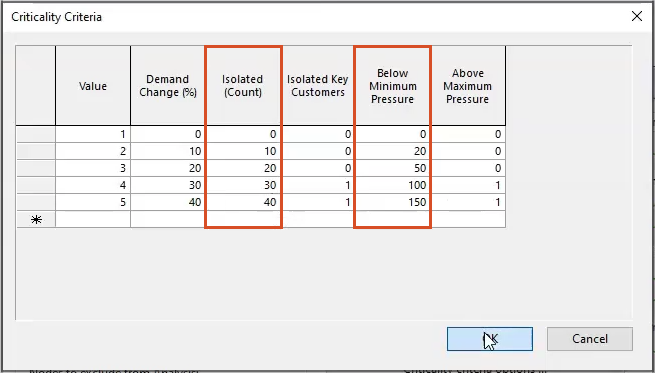
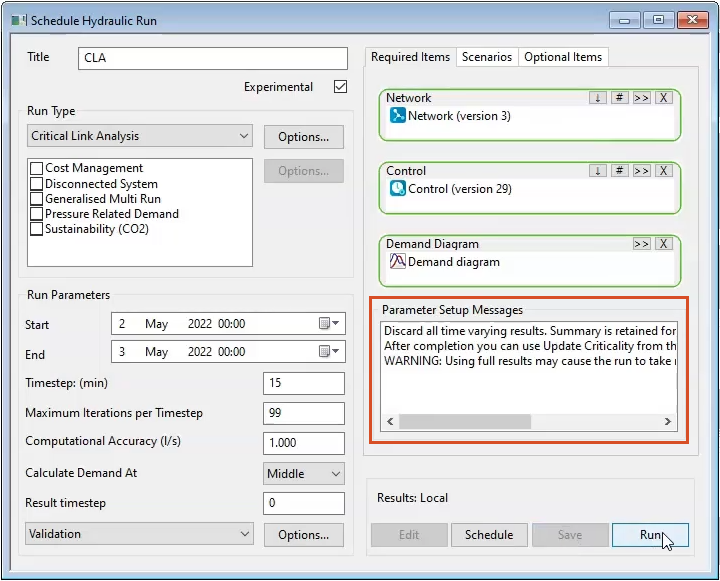
A notification appears with the number of simulations the CLA will run, and that it may take a long time.